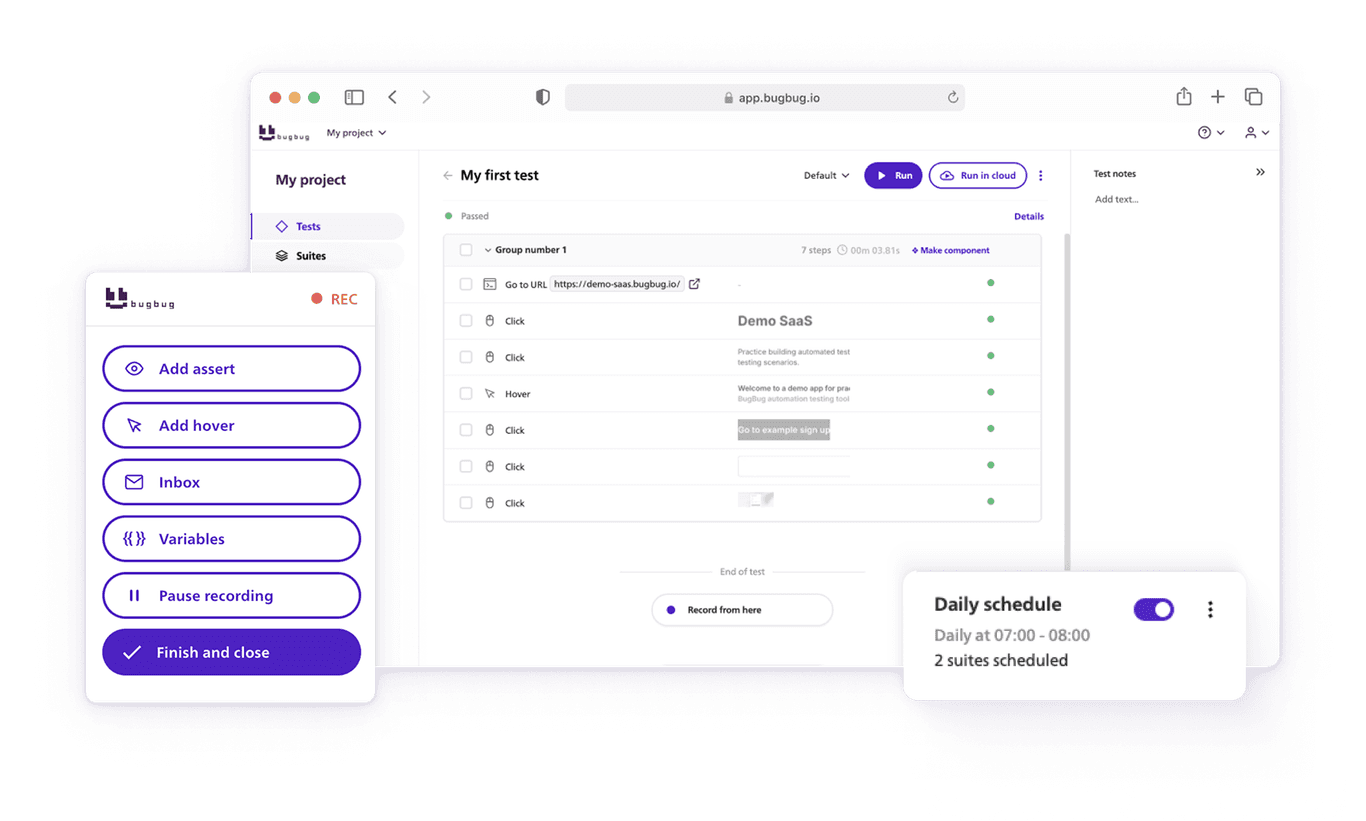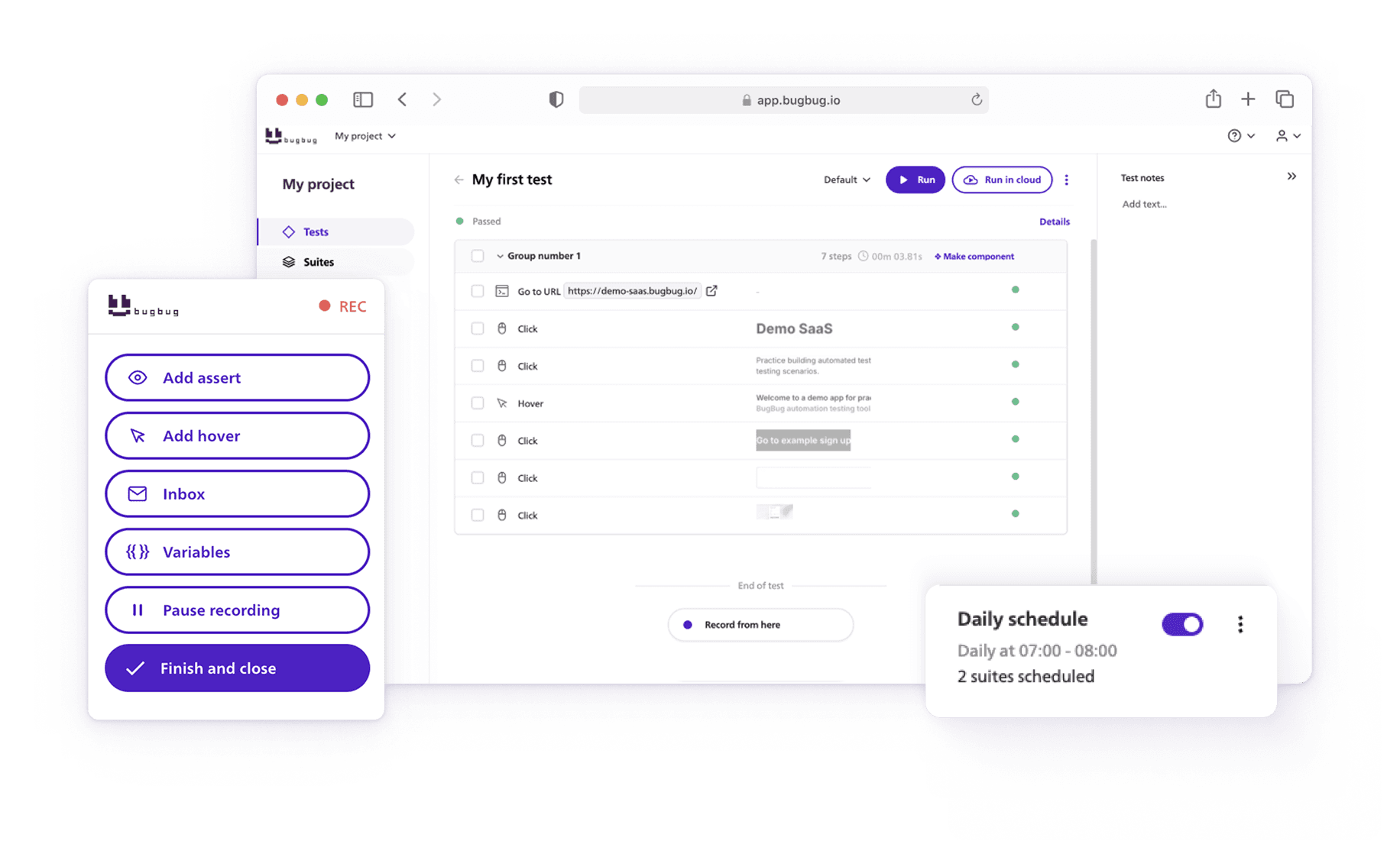In the world of software testing, there’s an unspoken truth many teams are still quietly grappling with: we’re burning hours, energy, and morale chasing bugs the hard way.
Picture this—your QA team, knee-deep in spreadsheets and step-by-step clickthroughs, performing regression testing late into the evening, trying to catch what the last rushed release broke. It’s a familiar scene, and an exhausting one. But here’s the kicker: most of it could be avoided.
We don’t accept rotary phones in our pockets or dial-up internet in our offices—so why are we still clinging to outdated testing methods?
- 🎯 TL;DR – Benefits of Test Automation
- 1. Cost Savings and ROI Maximization
- 2. Faster Test Execution and Accelerated Time to Market
- 3. Higher Accuracy and Fewer Human Errors
- 4. Expanded Test Coverage at Scale
- 5. Early Bug Detection with Shift-Left Testing
- 6. Better Resource Allocation and Happier Teams
- 7. Seamless CI/CD and DevOps Integration
- 8. Actionable Reporting and Data-Driven Decisions
- 9. Lower Risk and Improved Compliance
- 10. Enhanced Customer Satisfaction
- BugBug - The Codeless Solution
- Conclusion: Why Automation Testing Is a Must-Have
🎯 TL;DR – Benefits of Test Automation
- Massive Cost Savings & ROI: Automation drastically cuts the cost per test and saves hours daily—freeing teams to focus on value-adding tasks.
- Faster Releases & Dev Cycles: Automated tests run in minutes (not days), accelerating feedback loops and time to market.
- Higher Accuracy & Coverage: Eliminate human error and expand testing to cover more browsers, devices, and use cases.
- Early Bug Detection: Shift-left testing with automation catches bugs early—saving time, money, and customer trust.
The rise of software testing tools isn’t just a trend. It’s a reckoning. It’s a shift toward smarter, faster, and more reliable automated test cases that don’t get tired, don’t overlook steps, and don’t dread automated repetitive tasks. And yet, many teams are still hesitating—concerned about the learning curve, the cost of commercial tools, or the myth that automation is only for tech giants.
Check also:

Let’s be clear: the core benefits of automation testing are important, not just for speed, but for survival. Every time a test fails in production because something slipped through the cracks of a manual checklist, your customers—and your bottom line—feel it.
In this article, we’ll dive into why now is the time to rethink your QA strategy, the real-world benefits of shifting to automation, and the conclusion automation testing is pointing us toward: a more efficient, scalable, and human-friendly future for software development.
1. Cost Savings and ROI Maximization
Let’s talk money. Although there’s an initial setup cost to automation, it pays off quickly. Once automated test scripts are created, they can be run over and over again—without additional labor. This significantly reduces the need for human efforts in testing processes, allowing for 24X7 test execution and faster evaluation of software builds. Compared to manual testing processes, this drastically reduces the cost per test.
Tools like BugBug make this even more efficient. Users report saving 2–3 hours after each deployment and up to 60 minutes daily on test creation alone. That’s time you can invest back into your software development process.
2. Faster Test Execution and Accelerated Time to Market
Automation testing tools can execute test cases in a fraction of the time it takes humans. This leads to:
- Shorter test cycles
- Quicker feedback for developers
- Speedier development cycles
- Faster releases
Automating testing processes significantly reduces the feedback loop and enhances efficiency throughout the development cycle, allowing for quicker iterations and improved product quality.
This agility is essential in today’s competitive landscape. With BugBug, test runs that once took days now take minutes—making it ideal for continuous testing and rapid iteration.
3. Higher Accuracy and Fewer Human Errors
Humans are awesome—but we’re not perfect. Manual testers can make mistakes, especially with repetitive tasks or complex test cases.
By contrast, automation scripts execute the same test exactly the same way every time. This eliminates inconsistencies, improves test accuracy, and delivers more reliable results across the board.
Automate your tests for free
Test easier than ever with BugBug test recorder. Faster than coding. Free forever.
Get started
4. Expanded Test Coverage at Scale
Automated testing lets you go big. Enhanced test coverage is a key benefit of adopting a hybrid testing environment that combines automated and manual testing. You can test more scenarios, across more platforms, faster. Increased test coverage ensures thorough coverage of requirements and features. This includes:
- Cross browser testing
- Mobile testing
- Data driven testing
- Automated smoke testing
- Load testing
- Performance testing
BugBug allows you to run automated test execution locally or in the cloud—without extra infrastructure. That means you can scale effortlessly as your product grows.
5. Early Bug Detection with Shift-Left Testing
Automated testing supports the “shift-left” approach—catching bugs earlier in the development process, when they’re easier and cheaper to fix.
Running tests every time code is pushed enables automated regression testing and unit tests to be performed continuously. Each test cycle allows for the execution of a larger number of test cases, leading to better coverage of requirements and features. This not only improves software quality but helps you maintain momentum in your development cycles.
6. Better Resource Allocation and Happier Teams
No one wants to spend their day running repetitive tests. Automation testing helps by taking over those tasks, freeing up your test engineers and developers to:
- Create new test scripts
- Explore test scenarios manually
- Dive into advanced metrics
- Focus on high-impact work
With automation handling routine tasks, QAs can also focus on more complex activities, including ad hoc tests, which require human discernment and intellectual engagement.
The result? Increased morale, better team retention, and more innovative thinking.
7. Seamless CI/CD and DevOps Integration
Test automation is the backbone of Continuous Integration and DevOps. Tools like BugBug support integrations with GitHub, Jenkins, GitLab, and more—allowing you to trigger tests with every deployment. Accelerated test case execution enhances the feedback loop, enabling teams to detect bugs and improve functionality quickly.
This is critical if you want to perform testing as part of your CI/CD pipeline, reduce bottlenecks, and release confidently.
8. Actionable Reporting and Data-Driven Decisions
Most automated testing tools include built-in reporting dashboards that track:
- Test performance
- Failure trends
- System behavior
- Test data and metrics
- Detailed reports on various aspects of test performance
With BugBug, you get easy-to-read reports that eliminate the need for manual data entry—helping your testing team spot issues and make informed decisions faster. Additionally, BugBug can generate detailed reports regarding the scheduled test executions, enhancing the overall flexibility and efficiency of the testing process.
9. Lower Risk and Improved Compliance
Frequent, automated tests catch issues early—reducing the risk of shipping bugs to production. Automation testing can efficiently contribute to successful build validation by quickly running automated smoke tests, which generate the necessary datasets automatically, thus speeding up the stability assessment of software builds. This is especially important in regulated industries where you need to document and verify your testing process.
Automation helps validate configurations, ensure consistent results, and demonstrate compliance more easily.
10. Enhanced Customer Satisfaction
When your product works perfectly—across all operating systems, browsers, and devices—your users notice. Incorporating UI testing into your development process ensures that your application performs seamlessly, providing a consistent and reliable user experience. Fewer bugs, better UX, and more stable releases all contribute to happy, loyal customers.
Missed bugs and poor performance, on the other hand, lead to uninstalls, negative reviews, and lost trust.
BugBug - The Codeless Solution
BugBug is a lightweight yet powerful test automation tool built specifically for modern SaaS teams that need to perform end-to-end testing on websites and web applications—without the complexity. Its intuitive, no-code interface makes it easy for both technical and non-technical users to create and manage automated tests, streamlining the entire software testing process.
Using a Chrome extension, BugBug lets you record and replay user actions on your site, enabling fast and reliable test creation. With built-in features like scheduled test runs, parallel test execution, and seamless CI/CD integrations, you can automate more and worry less. Scalable for multiple test cases, BugBug also supports a hybrid testing environment, which enhances testing processes by enabling faster releases, improved test coverage, and increased availability.
Why Teams Choose BugBug
👾 Codeless test creation – Build automated tests in minutes, no coding required.
👾 Edit & Rewind – Jump to any step in a test, tweak it, and replay instantly—perfect for quick debugging.
👾 Scheduled test runs – Automate your testing routine with unlimited daily cloud tests to ensure your app stays reliable.
👾 Fast and lightweight – Simple setup, fast execution, and minimal overhead.
👾 Optimized for Chrome – Focused support for Chrome delivers top performance and stability.
👾 CI/CD ready – Plug your tests into your deployment pipeline with ease—supporting GitHub, GitLab, Jenkins, and more.
BugBug gives you the tools to scale your efforts and improve your software quality—all without writing a single line of code. Manual tests often come with the risk of human error, but BugBug's automation capabilities help mitigate these issues, allowing testers to focus on more complex tasks and ensuring higher accuracy in outcomes.
Automate your tests for free
Test easier than ever with BugBug test recorder. Faster than coding. Free forever.
Get started
If you’re looking for a practical, budget-friendly way to implement test automation, BugBug checks all the boxes:
✅ Affordable (most cost-effective in the market)
✅ Super user-friendly (no-code interface)
✅ Built for both technical and non-technical users
✅ Scalable for multiple test cases
✅ Excellent for hybrid testing environments
✅ Easily integrates with CI/CD pipelines
✅ Comes with smart features like custom JavaScript, profiles, and variables
With BugBug, your automation testing framework becomes a competitive advantage—not a complex engineering project.
Conclusion: Why Automation Testing Is a Must-Have
Let’s recap the benefits of test automation:
🚀 Faster test execution
💰 Cost savings and higher ROI
🔍 Early bug detection
✅ Improved test accuracy
📈 Enhanced test coverage
🔄 24/7 test runs that run automatically
🌍 Scalability across devices and browsers
🧠 Better use of human talent
📊 Data-driven insights
Ultimately, automation testing is important because it aligns with how modern software development teams work: faster, smarter, and more collaboratively. While it reduces human effort, it also minimizes the need for human intervention, boosts software quality, and makes your entire testing process more resilient.
If your team is still writing test cases manually and relying solely on manual testing, it’s time to upgrade. Start automating your tests today—and see how tools like BugBug can transform your QA game.
Want to learn more about how BugBug can help you streamline testing, accelerate releases, and improve product quality? Check it out here →



